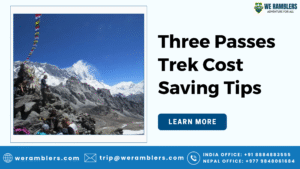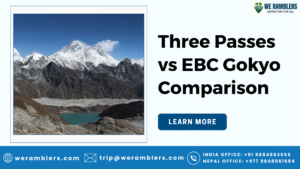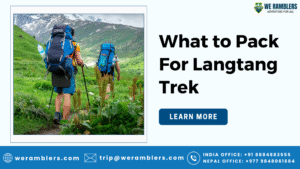Khumbu Glacier – Trekking to the Heart of Everest
The Khumbu Glacier is one of the most iconic and well-known glaciers in the world, not only for its sheer size but also for its unique location in the Everest region of Nepal. Positioned beneath the majestic Mount Everest, this massive river of ice is a central part of the Everest Base Camp trek, attracting thousands of adventurers each year.
What makes the Khumbu Glacier truly special is its connection to Everest expeditions, as climbers must cross the treacherous Khumbu Icefall at its western edge on their way to summit the highest mountain on Earth. For trekkers, walking alongside the glacier offers both geological wonder and a spiritual connection to the Himalayas.
Where Is the Khumbu Glacier Located and How Do You Access It?
The Khumbu Glacier lies in Sagarmatha National Park, in the northeastern part of Nepal, within the Solukhumbu District. It stretches from an elevation of about 7,600 meters near Everest to 4,900 meters at its terminus near Gorakshep.
To access the glacier, most trekkers begin their journey with a flight to Lukla Airport, followed by a trek through villages like Namche Bazaar, Tengboche, and Lobuche. Reaching the Khumbu Glacier requires you to be accompanied by a certified trekking guide, as per Nepal’s 2023 regulation banning solo trekking in high-altitude regions.
How Was the Khumbu Glacier Formed? Glacial Origins and Regional Significance
The Khumbu Glacier was formed during the last Ice Age, part of the larger glacial system that sculpted the Himalayan landscape. Over thousands of years, snow and ice compacted under their own weight, forming this valley glacier.
Today, it plays a critical role in the region’s hydrology, feeding rivers like the Dudh Koshi and serving as a key freshwater reserve. It is also spiritually significant to the Sherpa community, who consider the surrounding peaks sacred.
Facts About the Khumbu Glacier
Location: Situated in the Everest region of Sagarmatha National Park, Nepal.
Elevation Range: Extends from around 7,600 meters down to 4,900 meters above sea level.
Khumbu Icefall: Forms the dangerous and dramatic Khumbu Icefall, a key section on the Everest climbing route.
Glacial Retreat: Melting rapidly due to global warming, contributing to the formation of glacial lakes.
Significance: Plays a vital role in local hydrology and is a major highlight of the Everest Base Camp trek.
Ecosystem: Despite its icy terrain, supports limited but unique high-altitude flora and fauna.
Major Landmarks Around the Khumbu Glacier
Trekkers who reach the glacier can also explore:
- Everest Base Camp (EBC) – Situated near the end of the glacier
- Khumbu Icefall – The hazardous entry point to Everest’s summit route
- Kala Patthar – Offers panoramic views of Everest and the glacier below
- Gorakshep – Last teahouse village before EBC
- Lobuche and Pumori Base Camp – Alternate routes and viewpoints
All these landmarks are included in We Ramblers’ guided expeditions for a comprehensive Himalayan experience.
Trekking Routes That Lead to Khumbu Glacier
The most popular trekking route to the Khumbu glacier is the Everest Base Camp trek, which typically spans 12 to 14 days.
Alternative routes include:
- Gokyo Lakes & Cho La Pass trek – A scenic detour via turquoise lakes and a challenging high pass
- Three Passes Trek – A circuit combining EBC, Renjo La, Cho La, and Kongma La
- Island Peak with EBC – For those seeking to climb alongside trekking
We Ramblers offers expert-led tours on all these routes, ensuring acclimatization, safety, and support throughout.
What to Know Before You Trek to the Khumbu Glacier
Permits Required: TIMS Card, Sagarmatha National Park Entry Permit, and Khumbu Rural Municipality Permit
Guides Mandatory: Solo trekking is no longer allowed – you must trek with a certified guide
Fitness Prep: Train for high-altitude endurance and uneven terrain
Gear Up: Down jacket, thermal layers, hiking boots, and trekking poles are essential
Our dedicated team helps every traveler prepare thoroughly with gear lists, altitude tips, and expert guidance.

Itinerary for Trekking to Khumbu Glacier
Here’s a 12-day Khumbu Glacier trek itinerary:
Day 1: Fly to Lukla, trek to Phakding
Day 2: Trek to Namche Bazaar
Day 3: Acclimatization at Namche (hike to Everest View Hotel)
Day 4: Trek to Tengboche
Day 5: Trek to Dingboche
Day 6: Acclimatization hike to Nangkartshang Peak
Day 7: Trek to Lobuche
Day 8: Trek to Gorakshep, hike to EBC & Khumbu Glacier
Day 9: Early hike to Kala Patthar, return to Pheriche
Day 10–12: Descend to Lukla, fly back to Kathmandu
To get a detailed itinerary, please feel free to contact us.
Physical and Mental Challenges During Khumbu Glacier Trekking
- Altitude: Risk of Acute Mountain Sickness (AMS) above 4,000 meters
- Terrain: Moraines, boulders, ice ridges – requires sure-footedness
- Weather: Freezing temps, unpredictable snowfall, strong UV exposure
- Mental Challenge: Endurance, isolation, and long hiking days
That’s why our guides offer altitude management, emergency care, and motivation along the trail.
Best Time to Visit the Khumbu Glacier
The two best trekking windows are:
- Pre-Monsoon (March to May) – Wildflowers bloom, skies are clear, and temperatures are moderate
- Post-Monsoon (September to November) – Crisp views of the Khumbu Icefall, stable conditions
Avoid monsoon season (June–August) due to landslides and winter (Dec–Feb) due to extreme cold and snow.
Wildlife and Flora Around the Khumbu Glacier
Despite its harsh climate, the glacier region supports unique life:
- Flora: Alpine meadows, rhododendrons, blue pine, lichen
- Fauna: Himalayan tahr, snow leopard, musk deer, red panda
- Birds: Danphe (Himalayan monal), lammergeier, Himalayan griffon
Sagarmatha National Park is a UNESCO World Heritage Site and a haven for biodiversity.
Glacier Melting & Conservation Efforts in the Khumbu Region
The Khumbu Glacier is receding by approximately 30 meters annually, due to global warming. This results in:
- Expansion of glacial lakes, increasing flood risks
- Erosion of trails and formation of unstable moraines
Organizations like the Sagarmatha Pollution Control Committee (SPCC) and ICIMOD are promoting waste management and awareness. We Ramblers supports eco-friendly trekking practices and minimizes plastic use on its expeditions.
We Ramblers – Your Adventure Partner to the Khumbu Glacier
With years of experience in Nepal adventure tourism, We Ramblers offers curated trekking experiences across the Himalayas.
Our treks are led by licensed guides, with a strong focus on safety, sustainability, and local empowerment. Whether you’re eyeing the Khumbu Glacier, Annapurna Circuit, or Mardi Himal, we ensure a life-changing journey with high-altitude expertise and hospitality.
Frequently Asked Questions (FAQs) About Khumbu Glacier
1. Where is the Khumbu Glacier located?
The Khumbu Glacier is located in the Everest region of northeastern Nepal, within Sagarmatha National Park, a UNESCO World Heritage Site. It flows between Mount Everest and Lhotse-Nuptse Ridge, starting near the Western Cwm at around 7,600 meters and ending near Gorakshep at 4,900 meters.
2. How long is the Khumbu Glacier?
The Khumbu Glacier is approximately 17 kilometers (11 miles) long. It plays a major role in shaping the Everest Base Camp trek and supports various glacial lakes and rivers in the region.
3. Is the Khumbu Glacier melting?
Yes, the Khumbu Glacier is melting rapidly due to the impacts of global warming. It is contributing to the formation of glacial lakes and increasing the risk of glacial lake outburst floods (GLOFs) in the Himalayas.
4. What is the deepest crevasse on Everest?
While there’s no officially documented single “deepest” crevasse on Everest, crevasses in the Khumbu Icefall, part of the Khumbu Glacier, can reach depths of over 40 meters (130 feet). These deep fissures in the ice are one of the most dangerous obstacles climbers face en route to Everest’s summit.





